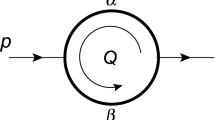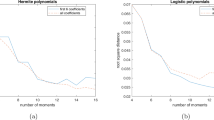Abstract
Laplace’s method is one of the fundamental techniques in the asymptotic approximation of integrals. The coefficients appearing in the resulting asymptotic expansion arise as the coefficients of a convergent or asymptotic series of a function defined in an implicit form. Due to the tedious computation of these coefficients, most standard textbooks on asymptotic approximations of integrals do not give explicit formulas for them. Nevertheless, we can find some more or less explicit representations for the coefficients in the literature: Perron’s formula gives them in terms of derivatives of an explicit function; Campbell, Fröman and Walles simplified Perron’s method by computing these derivatives using an explicit recurrence relation. The most recent contribution is due to Wojdylo, who rediscovered the Campbell, Fröman and Walles formula and rewrote it in terms of partial ordinary Bell polynomials. In this paper, we provide an alternative representation for the coefficients that contains ordinary potential polynomials. The proof is based on Perron’s formula and a theorem of Comtet. The asymptotic expansions of the gamma function and the incomplete gamma function are given as illustrations.
Similar content being viewed by others
References
Brassesco, S., Méndez, M.A.: The asymptotic expansion for n! and the Lagrange inversion formula. Ramanujan J. 24, 219–234 (2011)
Campbell, J.A., Fröman, P.O., Walles, E.: Explicit series formulae for the evaluation of integrals by the method of steepest descent. Stud. Appl. Math. 77, 151–172 (1987)
Comtet, L.: Advanced Combinatorics. Reidel, Dordrecht (1974)
De Angelis, V.: Asymptotic expansions and positivity of coefficients for large powers of analytic functions. Int. J. Math. Math. Sci. 2003, 1003–1025 (2003)
Dunster, T.M., Paris, R.B., Cang, S.: On the high-order coefficients in the uniform asymptotic expansion for the incomplete gamma function. Methods Appl. Anal. 5, 223–247 (1998)
Erdélyi, A.: Asymptotic Expansions. Dover, New York (1956)
López, J.L., Pagola, P., Pérez Sinusía, E.: A simplification of Laplace’s method: applications to the Gamma function and Gauss hypergeometric function. J. Approx. Theory 161, 280–291 (2009)
López, J.L., Pagola, P.: An explicit formula for the coefficients of the saddle point method. Constr. Approx. 33, 145–162 (2011)
Nemes, G.: On the coefficients of the asymptotic expansion of n!. J. Integer Seq. 13, 10.6.6 (2010)
Olver, F.W.J.: Error bounds for stationary phase approximations. SIAM J. Math. Anal. 5, 19–29 (1974)
Olver, F.W.J.: Asymptotics and Special Functions. Academic Press, New York (1974). Reprinted, A.K. Peters, Wellesley (1997)
Olver, F.W.J., Lozier, D.W., Boisvert, R.F., Clark, C.W. (eds.): NIST Handbook of Mathematical Functions. Cambridge University Press, New York (2010)
Paris, R.B., Kaminski, D.: Asymptotics and Mellin–Barnes Integrals. Cambridge University Press, Cambridge (2001)
Paris, R.B.: Hadamard Expansions and Hyperasymptotic Evaluation: An Extension of the Method of Steepest Descents. Cambridge University Press, Cambridge (2011)
Perron, O.: Über die näherungsweise Berechnung von Funktionen großer Zahlen. Sitzungsber. Bayr. Akad. Wissensch. (Münch. Ber.), 191–219 (1917)
Riordan, J.: Combinatorial Identities. Wiley, New York (1979)
Temme, N.M.: Uniform asymptotic expansions of the incomplete gamma functions and the incomplete beta function. Math. Comput. 29, 1109–1114 (1975)
Temme, N.M.: The asymptotic expansion of the incomplete gamma functions. SIAM J. Math. Anal. 10, 757–766 (1979)
Wojdylo, J.: On the coefficients that arise from Laplace’s method. J. Comput. Appl. Math. 196, 241–266 (2006)
Wojdylo, J.: Computing the coefficients in Laplace’s method. SIAM Rev. 48, 76–96 (2006)
Wong, R.: Asymptotic Approximations of Integrals. Academic Press, New York (1989). Reprinted, Classics Appl. Math., vol. 34. SIAM, Philadelphia (2001)
Acknowledgements
The author would like to thank the two anonymous referees for their thorough, constructive and helpful comments and suggestions on an earlier version of this paper. Especially, he wishes to thank the second referee, for bringing the relevance of Comtet’s work to his attention and giving suggestions for future research.
Author information
Authors and Affiliations
Corresponding author
Additional information
Communicated by Erik Koelink.
Appendix: Powers of Power Series
Appendix: Powers of Power Series
Let \(F ( x ) = 1 + \sum_{n = 1}^{\infty}{f_{n} x^{n} }\) be a formal power series. For any nonnegative integer k, we define the partial ordinary Bell polynomials B n,k (f 1,f 2,…,f n−k+1) (associated with F) by the generating function
so that B 0,0=1, B n,0=0 (n≥1), B n,1=f n , and \(\mathsf{B}_{n,2} = \sum\nolimits_{j = 1}^{n-1} {f_{j} f_{n - j} }\). From the simple identity, (F(x)−1)k+1=(F(x)−1)(F(x)−1)k, we obtain the recurrence relation
An explicit representation, that follows from the definition, is given by
where the sum runs over all sequences k 1,k 2,…,k n of nonnegative integers such that k 1+2k 2+⋯+(n−k+1)k n−k+1=n and k 1+k 2+⋯+k n−k+1=k.
For any complex number ρ, we define the ordinary potential polynomials A ρ,n (f 1,f 2,…,f n ) (associated with F) by the generating function
hence,
The first few are A ρ,0=1, A ρ,1=ρf 1, \(\mathsf{A}_{\rho,2} = \rho f_{2} + \binom{\rho}{2}f_{1}^{2}\), and, in general,
where the sum extends over all sequences k 1,k 2,…,k n of nonnegative integers such that k 1+2k 2+⋯+nk n =n and k 1+k 2+⋯+k n =k. Since (F(x))ρ=(F(x))ρ−1 F(x), we have the recurrence
In general, if \(G ( x ) = \sum\nolimits_{n = 0}^{\infty}{g_{n} x^{n} }\) is a formal power series, then by definition, we have
Specially,
For more details see, e.g., Comtet’s book [3, pp. 133–153].
Rights and permissions
About this article
Cite this article
Nemes, G. An Explicit Formula for the Coefficients in Laplace’s Method. Constr Approx 38, 471–487 (2013). https://doi.org/10.1007/s00365-013-9202-6
Received:
Revised:
Accepted:
Published:
Issue Date:
DOI: https://doi.org/10.1007/s00365-013-9202-6




